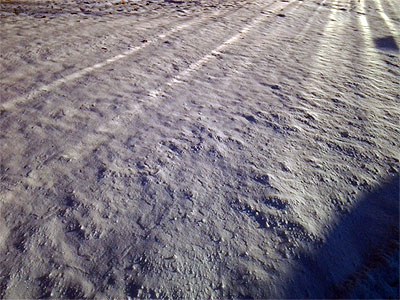When Robert Frost wrote “Stopping by the Woods on a Snowy Evening,” he probably wasn’t thinking about the educational lives of young adolescents. And as the speaker in Frost’s poem trotted through the snow on horseback, he probably wasn’t thinking about how to assess 10- to 15-year-olds. Yet somehow, Frost’s poem and his snowy setting relate to what we do for the kids in our classrooms.
Over the past few days, many inches of snow have fallen around my house, upon the sidewalks, and on the streets of my town, and as the flakes have floated and collected into large drifts, I’ve thought about how it all relates to middle level education. In particular, I realized that how we see our world in middle level education is often affected by the speed we are going when we see it.
When I am driving through newly-plowed streets, I tend to look at snow as something that obscures, something that constrains, something that is potentially hazardous. With white-knuckled hands, I grip the steering wheel hoping that everyone stays in his or her lane—even when the lane markers are covered in a thick, icy film.
I carefully peer through my foggy windshield, hunting for turns that now aren’t as familiar as they were in the Fall and taking them with new trepidation. I am anxious about my journey because I am in a hurry, the snow is a chilly variable, and I have “promises to keep/And miles to go before I sleep.”
As we reenter the school house in January with a new semester, it’s easy to have the same kind of anxious feelings—especially if we are in a race to reach our destination. With mandatory assessments just around the bend, we tend to grip our data folders with white-knuckled hands hoping that every student gets in the correct lane towards success.
We often look at our students through critical lenses to hunt for the things we need to “fix” before the test arrives, and we are afraid to take new instructional or curricular turns because they may lead our students away from their prescribed “lanes.”
We grow anxious about the educational path ahead because we are driven to achieve (numerically), students are a fickle variable, and we have just a few months and “miles to go” before the big test. But what does this hurry and anxiety about assessment do to the culture and climate of the school house? How does this change in pace change our relationships with our middle grades students and each other?
Perhaps we should begin January 2014 and the new semester by answering these questions and by adopting a “slow down” plan that benefits our kids, our school, and our profession. And this relates to how I see snow when I park the car and walk inside—with intentional slowness.
Instead of seeing snow as something hazardous, I see it as something that shines, something that reflects, and something that is potentially wonderful.
I am still careful in my footing, but I am no longer fearful as I step forward towards my destination. And the snow has not changed; I have simply changed my pace. Therefore, as we reenter the school house, we should keep our data folders, our critical lenses, and our best instructional plans in our hands, but we should also keep our young adolescents and their unique needs in mind.
We should continue to make lesson plans but we should also work on school-wide “lessen plans” that focus with deliberate attention on our students for the right reasons, not just the numerical and quantifiable ones. Our students shine and reflect and have the potential to be wonderful like the snow around us. We just need to remember to slow down and see them that way (again), for we have “promises to keep/And miles to go before [we] sleep.”
This We Believe Characteristics
- Educators value young adolescents and are prepared to teach them.
- Varied and ongoing assessments advance learning as well as measure it.
- Organizational structures foster purposeful learning and meaningful relationships.
- The school environment is inviting, safe, inclusive and supportive of all.
Haiku
This white breath of air
A hushing push of winter;
Brightens the way home.
